key Citroen BERLINGO MULTISPACE 2015 2.G User Guide
[x] Cancel search | Manufacturer: CITROEN, Model Year: 2015, Model line: BERLINGO MULTISPACE, Model: Citroen BERLINGO MULTISPACE 2015 2.GPages: 298, PDF Size: 12.69 MB
Page 51 of 298
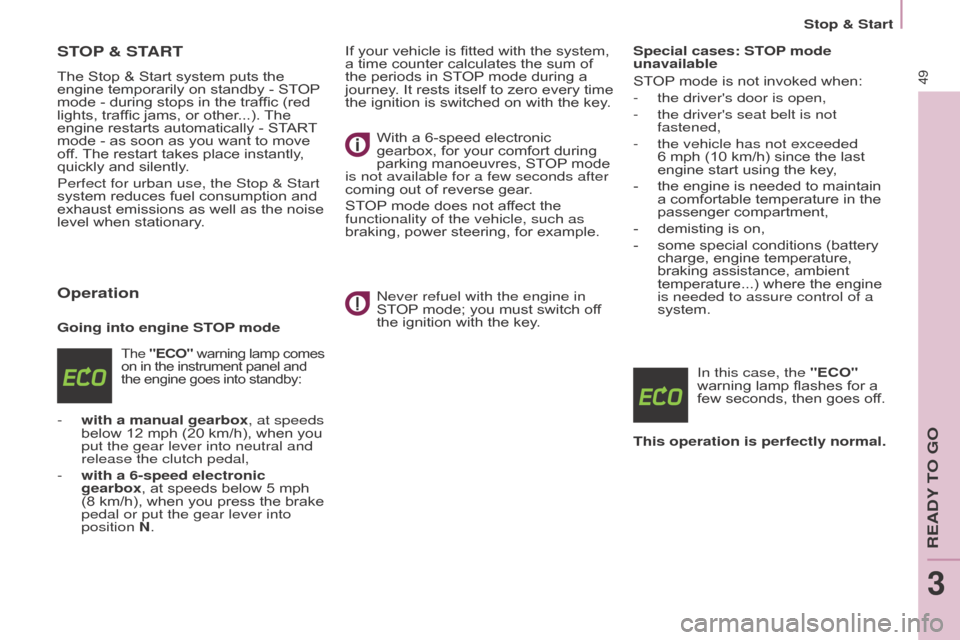
Berlingo-2-VP_en_Chap03_Pret-a-partir_ed01-2015Berlingo-2-VP_en_Chap03_Pret-a-partir_ed01-2015
49
STOP & START
The Stop & Start system puts the engine
temporarily on standby - STOP mode
- during stops in the traffic (red
lights,
traffic jams, or other...).
The
engine
restarts automatically - START
mode
- as soon as you want to move
of
f.
The
restart takes place instantly,
quickly
and silently.
Perfect for urban use, the Stop & Start
system
reduces fuel consumption and
exhaust
emissions as well as the noise
level
when stationary.
Operation
Going into engine STOP mode
The "ECO" warning lamp comes on
in the instrument panel and the
engine goes into standby:
- with a manual gearbox , at speeds
below 12 mph (20 km/h), when you
put the gear lever into neutral and
release the clutch pedal,
-
with
a 6-speed electronic
gearbox,
at speeds below 5 mph
(8
km/h), when you press the brake
pedal or put the gear lever into
position
N. If
your vehicle is fitted with the system,
a
time counter calculates the sum of
the
periods in STOP
mode during a
journey
. It rests itself to zero every time
the
ignition is switched on with the key.
With a 6-speed electronic
gearbox,
for your comfort during
parking
manoeuvres, STOP
mode
is not available for a few seconds after
coming
out of reverse gear.
STOP
mode does not affect the
functionality of the vehicle, such as
braking,
power steering, for example.
n
ever refuel with the engine in
STOP
mode; you must switch off
the
ignition with the key.Special cases: STOP mode
unavailable
STOP
mode is not invoked when:
-
the driver's door is open,
-
the driver's seat belt is not
fastened,
-
the vehicle has not exceeded
6 mph
(10 km/h) since the last
engine
start using the key,
-
the
engine is needed to maintain
a
comfortable temperature in the
passenger
compartment,
-
demisting
is on,
-
some
special conditions (battery
charge,
engine temperature,
braking
assistance, ambient
temperature...)
where the engine
is needed to assure control of a
system.
In this case, the
"ECO"
warning lamp flashes for a
few
seconds, then goes off.
This operation is perfectly normal.
Stop & Start
REadY To Go
3
Page 53 of 298

Berlingo-2-VP_en_Chap03_Pret-a-partir_ed01-2015Berlingo-2-VP_en_Chap03_Pret-a-partir_ed01-2015
51
Reactivation
Press the "ECO OFF" switch again.
The system is active again; this is
confirmed
by the switch warning
lamp
going off and a message in the
instrument
panel.
The
system is reactivated
automatically
at every new start
using
the key.
Operating fault
In the event of a malfunction with the system, the "ECO
OFF"
switch warning lamp
flashes,
then comes on
continuously
.
Maintenance
Before working under the bonnet, deactivate the Stop & Start system
to
avoid any risk of injury resulting
from
automatic operation of START
mode.
This
system requires a specific
battery
with a special specification
and
technology (reference numbers
available
from a CITROËN dealer or a
qualified
workshop).
Fitting a battery not listed by
CITROËN introduces
the risk of
malfunction
of the system.
The
Stop & Start system makes
use
of advanced technology.
All
work
on this type of battery must
be done only by a CITR
o Ë n dealer or
a
qualified workshop.
have
it
checked
by
a
CITROËN
dealer
or
a
qualified
workshop.
In
the
event
of
a
fault
in
STOP
mode,
the
vehicle
may
stall.
All
of
the
warning
lamps
in
the
instrument
panel
come
on.
It
is
then
necessary
to
switch
off
the ignition and start the engine again
using
the
key.
Stop & Start
REadY To Go
3
Page 54 of 298

Berlingo-2-VP_en_Chap03_Pret-a-partir_ed01-2015
52
Good practice when stopping Good practice when starting
Diesel pre-heating warning
lamp
If the temperature is high
enough,
the warning lamp
comes
on for less than
one
second, you can start
without
waiting.
In cold weather, wait for this warning
lamp
to
go off then operate the starter
(Starting position) until the engine
starts.
Door or bonnet open warning lamp
If this comes on, a door or the bonnet
is
not closed correctly, check!
Minimise engine and gearbox wear
When switching off the ignition, let the
engine run for a few seconds to allow
the turbocharger (
d iesel engine) to
return
to idle.
d
o not press the accelerator when
switching
off the ignition.
There is no need to engage a gear
after
parking the vehicle.
STARTING AND ST OPPING
Running and accessories position.
To
unlock the steering, turn the
steering wheel gently while turning the
key
, without forcing. In this position,
certain
accessories can be used.
Starting position.
The starter is operated, the engine
turns
over, release the key.
STOP position:
steering lock.
The
ignition is off.
T
urn the steering
wheel
until the steering locks. Remove
the
key.
Starting and stopping
Page 103 of 298

101
Berlingo-2-VP_en_Chap04_Ergonomie_ed01-2015Berlingo-2-VP_en_Chap04_Ergonomie_ed01-2015
Automatic switching on/off
The front courtesy lamp comes on when the key is removed from the ignition, when the
vehicle is unlocked, when one of the
front doors is opened and for location of
the
vehicle using the remote control.
It goes off gradually after the ignition is
switched on and when the vehicle is
locked.Front seats: comes on when one of the front doors is
opened. These are switched on and of
f by
means of a manual switch, with
the
ignition on.
Rear
seats: comes on when
one of the rear doors is
opened.
If
the doors remain open for
a
few minutes, the courtesy
lamps
go off.
Permanently
off.
Permanently
on,
ignition
on.
Front courtesy lamp
COURTESY
LAMPS
Rear courtesy lamp Front individual reading lamps
EaSE oF USE and CoMFoRT
4
Practical information
Page 131 of 298
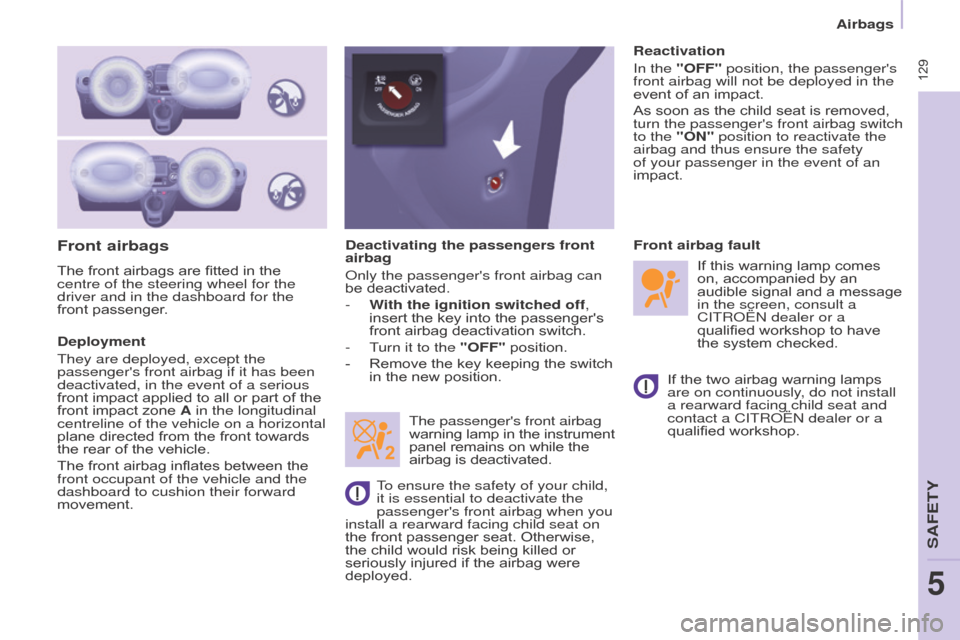
Berlingo-2-VP_en_Chap05_Securite_ed01-2015
129
Front airbags
Deployment
They are deployed, except the
passenger's front airbag if it has been
deactivated, in the event of a serious
front impact applied to all or part of the
front
impact zone A in the longitudinal
centreline of the vehicle on a horizontal
plane
directed from the front towards
the
rear of the vehicle.
The
front airbag inflates between the
front occupant of the vehicle and the
dashboard to cushion their forward
movement. Deactivating the passengers front
airbag
o
nly the passenger's front airbag can
be deactivated.
-
W
ith the ignition switched off,
insert the key into the passenger's front
airbag deactivation switch.
- T urn it to the "OFF" position.
-
Remove
the key keeping the switch
in
the new position.
The passenger's front airbag
warning
lamp
in
the
instrument panel
remains on while the
airbag
is deactivated.If
the two airbag warning lamps
are on continuously
, do not install
a rearward facing child seat and
contact a CITR
o Ë n dealer or a
qualified
workshop.
Front airbag fault
To ensure the safety of your child,
it is essential to deactivate the
passenger's front airbag when you
install a rearward facing child seat on
the
front passenger seat. Otherwise,
the
child would risk being killed or
seriously
injured if the airbag were
deployed.Reactivation
In the
"OFF" position, the passenger's
front airbag will not be deployed in the
event of an impact.
As soon as the child seat is removed,
turn the passenger's front airbag switch
to the
"ON" position to reactivate the
airbag and thus ensure the safety
of your passenger in the event of an
impact.
If this warning lamp comes
on,
accompanied by an
audible
signal and a message
in the screen, consult a
CITR
o Ë n dealer or a
qualified workshop to have the
system checked.
The
front airbags are fitted in the
centre of the steering wheel for the
driver and in the dashboard for the
front
passenger.
airbags
SaFETY
5
Page 145 of 298
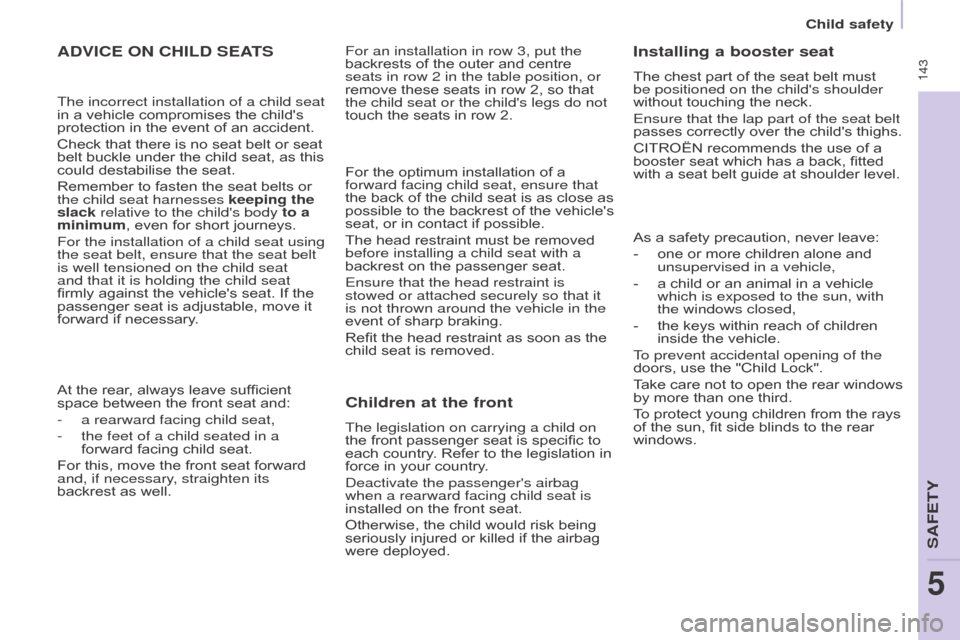
Berlingo-2-VP_en_Chap05_Securite_ed01-2015
143
ADVICE ON CHILD SEATS
At the rear, always leave sufficient space between the front seat and:
-
a rearward facing child seat,
-
the feet of a child seated in a
forward
facing child seat.
For
this, move the front seat forward
and, if necessary
, straighten its
backrest
as well.
The incorrect installation of a child seat
in
a vehicle compromises the child's
protection
in the event of an accident.
Check that there is no seat belt or seat
belt
buckle under the child seat, as this
could
destabilise the seat.
Remember to fasten the seat belts or
the child seat harnesses
keeping the
slack relative to the child's body to a
minimum, even for short journeys.
For the installation of a child seat using
the seat belt, ensure that the seat belt
is well tensioned on the child seat
and that it is holding the child seat
firmly against the vehicle's seat. If the
passenger
seat is adjustable, move it
forward
if necessary. For the optimum installation of a
forward facing child seat, ensure that
the
back of the child seat is as close as
possible
to the backrest of the vehicle's
seat,
or in contact if possible.
The head restraint must be removed
before installin
g a child seat with a
backrest on the passenger seat.
Ensure that the head restraint is
stowed or attached securely so that it
is not thrown around the vehicle in the
event of sharp braking.
Refit the head restraint as soon as the
child
seat is removed.Children at the front
The legislation on carrying a child on
the
front passenger seat is specific to
each
country. Refer to the legislation in
force
in your country.
d
eactivate the passenger's airbag
when a rearward facing child seat is
installed
on the front seat.
Otherwise,
the child would risk being
seriously
injured or killed if the airbag
were
deployed.
Installing a booster seat
The chest part of the seat belt must be positioned on the child's shoulder
without touching the neck.
Ensure that the lap part of the seat belt
passes
correctly over the child's thighs.
CITROËN
recommends the use of a
booster
seat which has a back, fitted
with
a seat belt guide at shoulder level.
As
a safety precaution, never leave:
-
one
or more children alone and
unsupervised in a vehicle,
-
a
child or an animal in a vehicle
which is exposed to the sun, with
the windows closed,
-
the
keys within reach of children
inside
the vehicle.
To prevent accidental opening of the
doors,
use the "Child Lock".
Take
care
not
to
open
the
rear
windows
by
more than one third.
To
protect young children from the rays
of
the sun, fit side blinds to the rear
windows.
For an installation in row 3, put the
backrests
of
the
outer
and
centre
seats in row 2 in the table position, or
remove
these
seats
in
row
2,
so
that
the child seat or the child's legs do not
touch
the
seats
in
row
2.
Child safety
SaFETY
5
Page 146 of 298

Berlingo-2-VP_en_Chap05_Securite_ed01-2015
144
CHILD LOCK
This prevents opening of the siding
side doors from the inside.
Manual Electric
With the ignition on, press
this
button in the middle of
the
dashboard.
Indicator
lamp on = child lock
on.
Please
note: this system is
independent
of the central locking
control.Always
remove the ignition key
when leaving the vehicle, even for
a
short time.
It
is
advisable to check the state of
the
child
lock each time the ignition is
switched
on.
In
the
event of a serious impact the
electric
child lock is deactivated
automatically
.
a label indicates the position of the
lever
and
the
state
of
the
child
lock.
-
o
pen fully past the point of
resistance.
-
T
ilt the lever, located on the rear
section
of
the
door.
Child safety
Page 149 of 298

147
Berlingo-2-VP_en_Chap06_Accessoire_ed01-2015
TOWBAR WITH SWAN NECK T
OWBALL ,
LOCKABLE
AND
QUICKL
Y
DET
ACHABLE
Presentation
This swan neck towbar, delivered assembled, can be removed and fitted
easily
. No tools are needed.
Instructions for fitting and before
every use
Check
that the swan neck is correctly
locked
by verifying the following points:
-
the
green mark on the locking
wheel is visible
-
the
safety lock on the locking wheel
is directed toward the rear
,
-
the
safety lock is closed and the
key
removed; the locking wheel can
no longer be operated,
-
the
swan neck must no longer
move
at all in its carrier.
When
hooking up the trailer, don't
forget
to connect the trailer harness.
Fitting
Towing a trailer
ACCESSORIES
6
Page 158 of 298
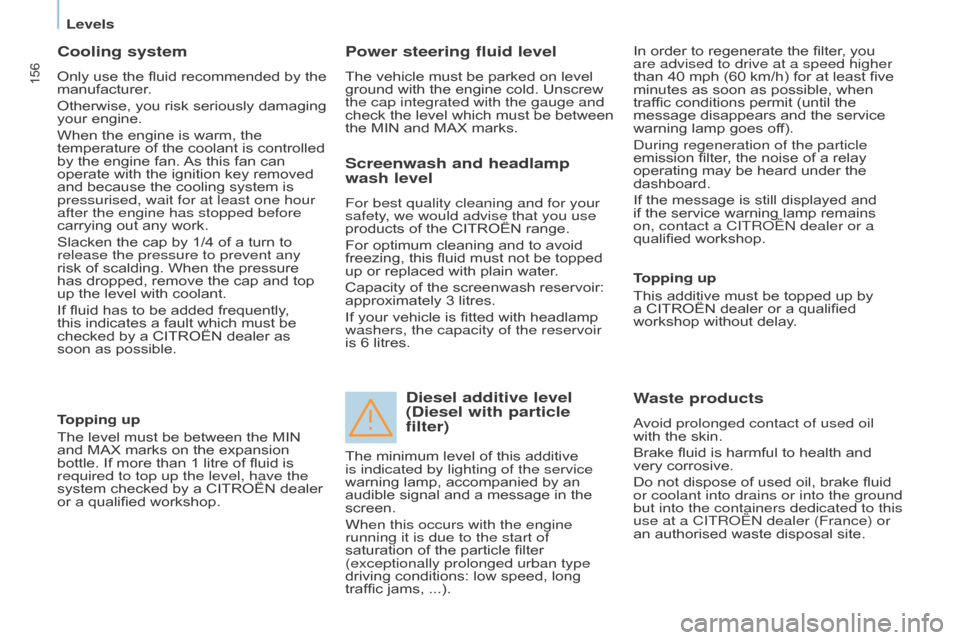
156
Berlingo-2-VP_en_Chap07_Verification_ed01-2015Berlingo-2-VP_en_Chap07_Verification_ed01-2015
Cooling system
Only use the fluid recommended by the manufacturer.
Otherwise,
you risk seriously damaging
your
engine.
When
the engine is warm, the
temperature
of the coolant is controlled
by
the engine fan.
As
this fan can
operate
with the ignition key removed
and
because the cooling system is
pressurised, wait for at least one hour
after the engine has stopped before
carrying
out any work.
Slacken
the cap by 1/4 of a turn to
release the pressure to prevent any
risk
of scalding. When the pressure
has
dropped, remove the cap and top
up
the level with coolant.
If
fluid has to be added frequently,
this
indicates a fault which must be
checked
by a CITROËN dealer as
soon
as possible.
Power steering fluid level
The vehicle must be parked on level ground with the engine cold. Unscrew
the cap integrated with the gauge and
check
the level which must be between
the
MIN and MAX marks. In
order to regenerate the filter, you are advised to drive at a speed higher
than
40 mph (60 km/h) for at least five minutes
as soon as possible, when
traffic
conditions permit (until the
message
disappears and the service
warning
lamp goes off).
d
uring regeneration of the particle
emission
filter, the noise of a relay
operating
may be heard under the
dashboard.
If
the message is still displayed and
if
the service warning lamp remains
on, contact a CITR
o Ë n dealer or a
qualified
workshop.
Topping up
The
level
must
be
between
the
MIN
and
MAX
marks
on
the
expansion
bottle.
If
more
than
1
litre
of
fluid
is
required to top up the level, have the
system
checked
by
a
CITROËN
dealer
or
a
qualified
workshop.
Screenwash and headlamp
wash level
For best quality cleaning and for your
safety, we would advise that you use
products of the CITROËN range.
For
optimum cleaning and to avoid
freezing,
this fluid must not be topped
up
or replaced with plain water.
Capacity
of the screenwash reservoir:
approximately
3 litres.
If
your vehicle is fitted with headlamp
washers, the capacity of the reservoir
is
6 litres.
Diesel additive level
(Diesel with particle
filter)
Topping up
This additive must be topped up by
a
CITROËN dealer or a qualified
workshop
without delay.
Waste products
avoid prolonged contact of used oil
with the skin.
Brake
fluid is harmful to health and
very
corrosive.
Do
not dispose of used oil, brake fluid
or coolant into drains or into the ground
but into the containers dedicated to this
use at a CITR
o Ë n dealer (France) or
an
authorised waste disposal site.
The
minimum
level
of
this
additive
is indicated by lighting of the service
warning
lamp,
accompanied
by
an
audible
signal
and
a
message
in
the
screen.
When this occurs with the engine
running it is due to the start of
saturation
of
the
particle
filter
(exceptionally prolonged urban type
driving
conditions:
low
speed,
long
traffic
jams,
...).
Levels
Page 161 of 298
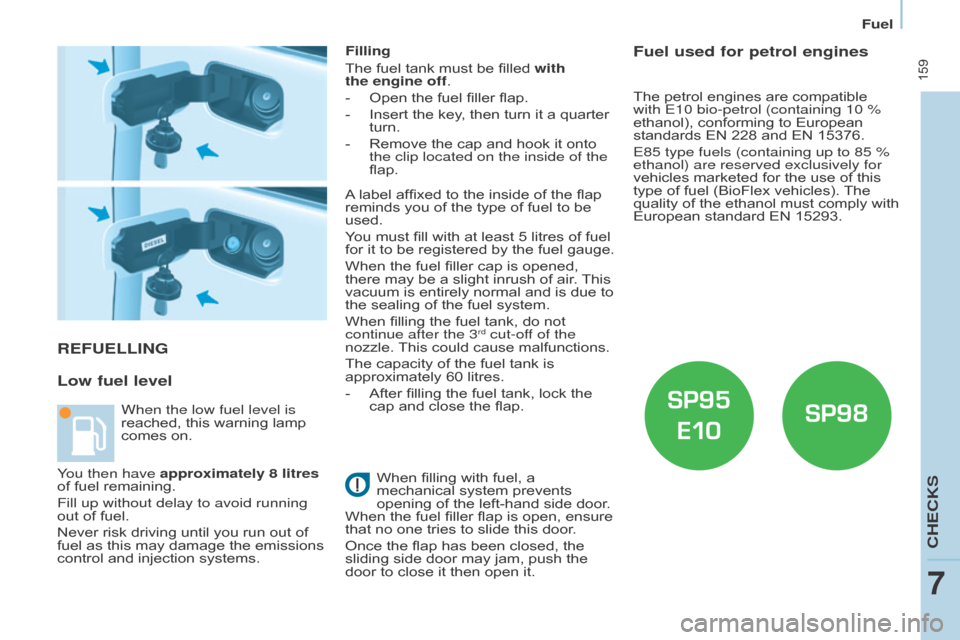
159
Berlingo-2-VP_en_Chap07_Verification_ed01-2015Berlingo-2-VP_en_Chap07_Verification_ed01-2015
REFUELLING
Low fuel level
Filling
The fuel tank must be filled with
the
engine off.
-
Open
the fuel filler flap.
-
Insert
the key, then turn it a quarter
turn.
-
Remove
the cap and hook it onto
the clip located on the inside of the
flap.
When
filling with fuel, a
mechanical
system prevents
opening
of the left-hand side door.
When
the fuel filler flap is open, ensure
that
no one tries to slide this door.
Once
the flap has been closed, the
sliding
side door may jam, push the
door
to close it then open it.
When the low fuel level is
reached,
this
warning
lamp
comes
on. A
label affixed to the inside of the flap
reminds
you of the type of fuel to be
used.
Y
ou must fill with at least 5 litres of fuel
for
it to be registered by the fuel gauge.
When
the fuel filler cap is opened,
there
may be a slight inrush of air.
This
vacuum
is entirely normal and is due to
the
sealing of the fuel system.
When
filling the fuel tank, do not
continue after the 3rd cut-off of the
nozzle.
This
could
cause malfunctions.
The
capacity
of
the
fuel tank is
approximately
60
litres.
-
After
filling
the
fuel tank, lock the
cap
and
close
the flap.
Fuel used for petrol engines
The petrol engines are compatible with E10 bio-petrol (containing 10 %
ethanol), conforming to European
standards
EN 228 and EN 15376.
E85 type fuels (containing up to 85 %
ethanol) are reserved exclusively for
vehicles
marketed for the use of this
type
of fuel (BioFlex vehicles).
The
quality
of the ethanol must comply with
European
standard EN 15293.
You then have approximately 8 litres
of
fuel
remaining.
Fill up without delay to avoid running
out
of
fuel.
Never
risk
driving
until
you
run
out
of
fuel
as
this
may
damage
the
emissions
control
and
injection
systems.
CHECKS
7
Fuel